|
Tuesday, September 25, 2007
Progress Notes
Last week we were delighted to receive some old Bank of Tuscumbia calendars from a member of the Glawson family who found them stored away in his Aunt Wilma's home near Tuscumbia on Lick Creek. The series of calendars extended through the years 1943 to 1963. Each one featured a beautiful landscape or home, sometimes the work of an artist, other times a photographer. The one I have pictured here (photo 1) is of an Ozark hills landscape. Each calendar was replete with useful information for the farmer, because in those days, most banks customers around Tuscumbia were farmers. I have uploaded here some photos taken of the tables of information as well as the year's weather forecast (photos 2, 3, 4, 5). You may have to magnify the image to read some of the fine print.
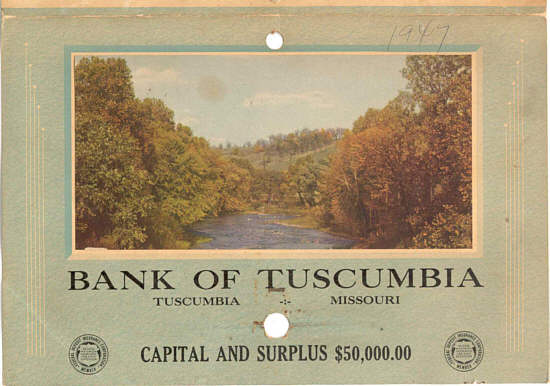 1 Bank Calendar Photo
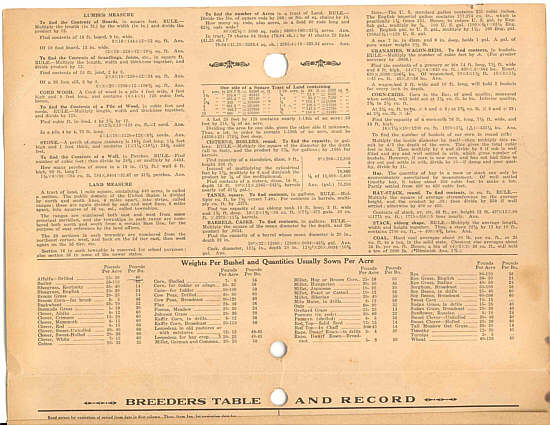 2 Bank Calndar
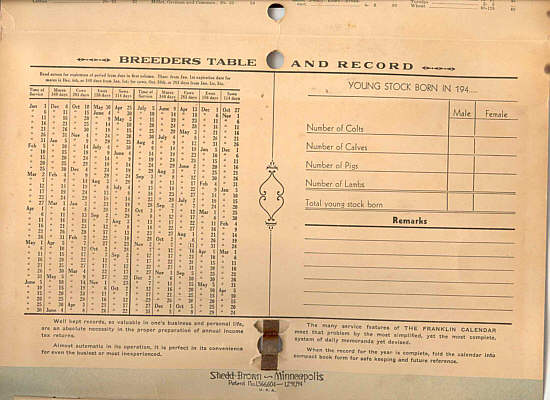 3 Bank Calendar
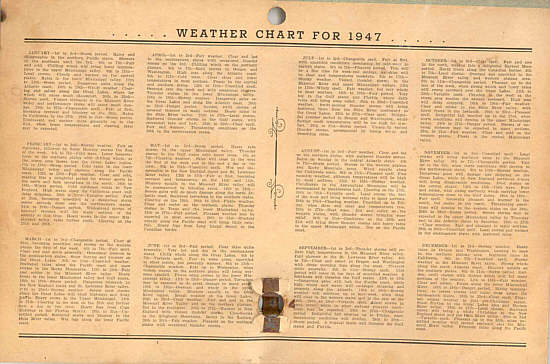 4 Bank Calendar
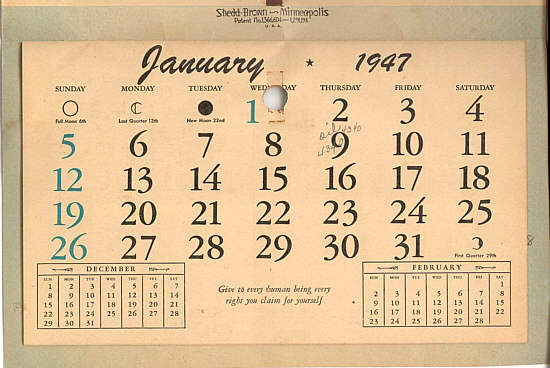 5 Bank Calendar The local banks in Miller County have been kind to us having given us significant donations for our building program. The Bank of Tuscumbia (now known as Central Bank) was no exception. We enjoy our relationship with the staff (Kathy Snodgrass and Denise Wilson and President Carl Kemna, photo 6) who have been very helpful to us through the years in various ways. The bank was organized in 1902 by Robert M. Marshall, who had recently retired from his profession as steamboat captain on the Osage. Refer to our own website to read the biography of this important figure in Miller County's history including more information about his role in organizing the bank: (click here)
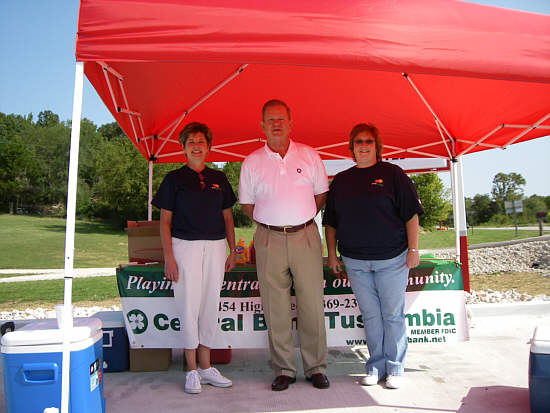 6 Kathy Snodgrass,Carl Kemna,Denise Wilson Central Bank The bank originally was a stone building (photo 7) built under the hill facing the Presbyterian Church near the steps (photo 8) which led up the hill to the courthouse. Some of the people who were officers or worked there included Fred Fendorf, who is pictured in this photo with Captain Bob Marshall, the bank president (photo 9), Walter Stillwell, Byron Hix, Glen Warren, and Ralph Riemensnider. In 1960 the bank and the post office were moved to the top of the hill on High street, the same street where the Courthouse at that time was located. An open house was given October 9, 1960 to celebrate the new structure which combined both bank and post office (photo 10). The old post office also had been located under the hill in Tuscumbia. The post office (photo 11) faced Hauenstein's Store. It was a concrete building which originally had been built by James Spearman for use as a restaurant in the early 1900's which he later rented to Madison Bear for the same purpose. However, this was not the first post office as an earlier post office, which had been located approximately midway between the Spearman building and the old Woodman's Hall (photo 12), had burned. Cletus Burris, our current postmaster in Tuscumbia, found a notebook which recorded the handwritten names of those who attended the celebration the day the new bank and post office were opened (photos 13,14,15,16,17). I thought it might be interesting to some to see who was there that day. You will notice that people came from most areas of the county to see the new building. The bank has remained in this location but the post office moved once again just a short distance north on highway 52 to occupy the building (photo 18) built by Dewey Kallenbach years ago for his appliance store after he sold his interest in the old Hauenstein Store under the hill to Dorsey Barrons. Talking about banks reminds me that my father and his brothers made all types of little novelty coin banks out of red cedar to sell to tourists at the Lake. Here is pictured one of them (photo 19). That's probably not too relevant, I suppose, especially since the business is no longer in existence.
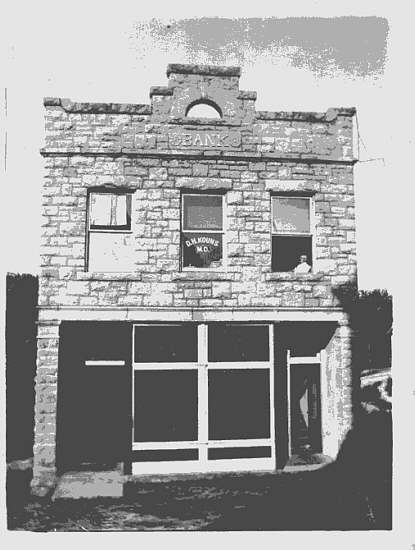 7 Old Bank
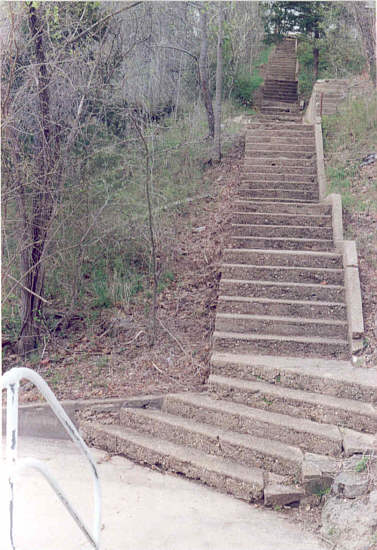 8 steps up to courthouse
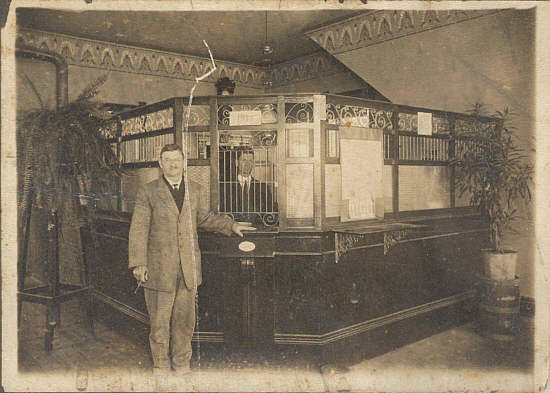 9 Robert Marshall and Fred Fendorf
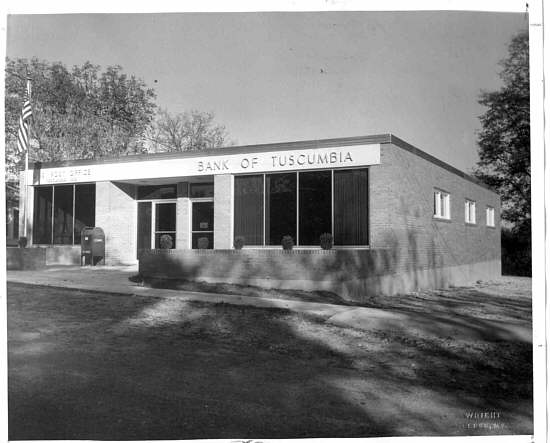 10 bank and postoffice 1960
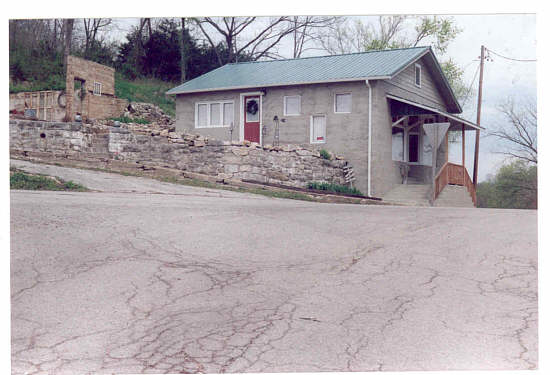 11 Current photo of old post office under the hill
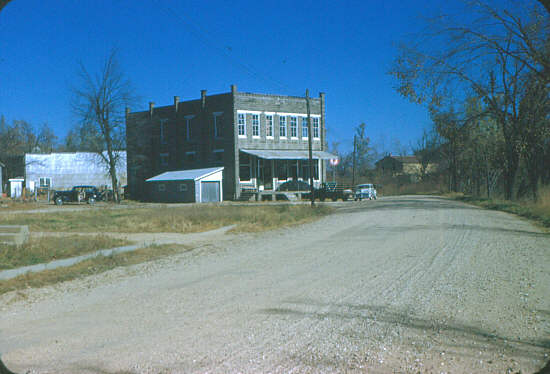 12 Old Woodman's Hall
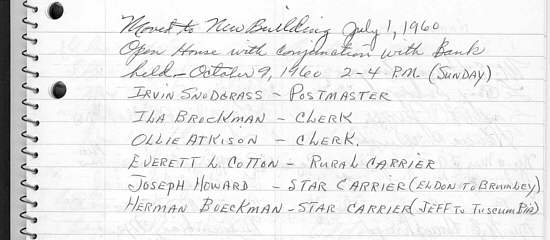 13 Open House
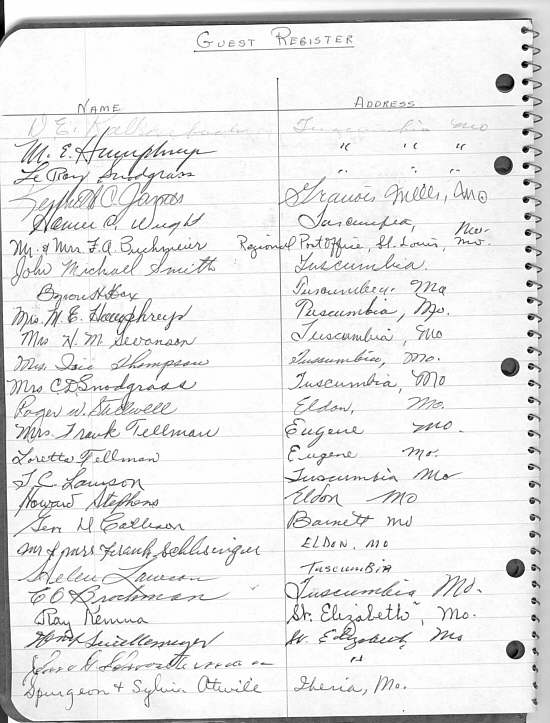 14 Open House
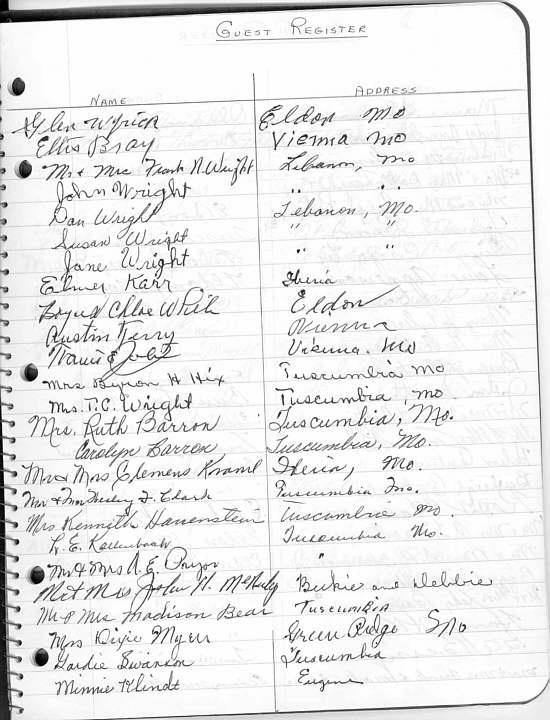 15 Open House
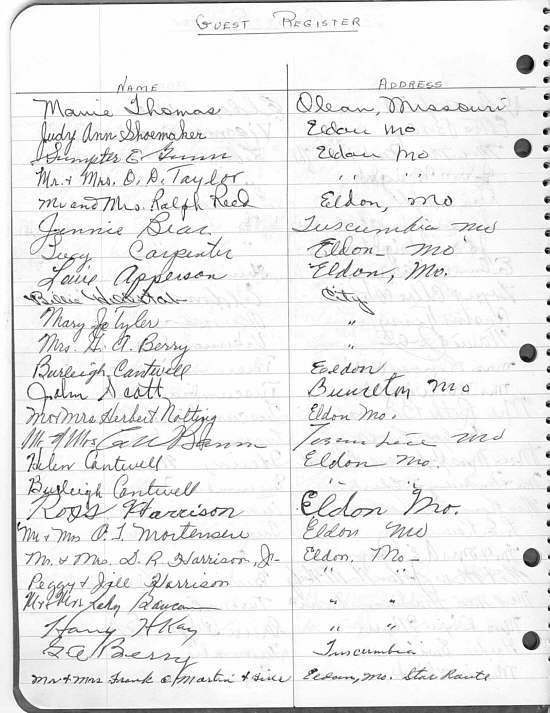 16 Open House
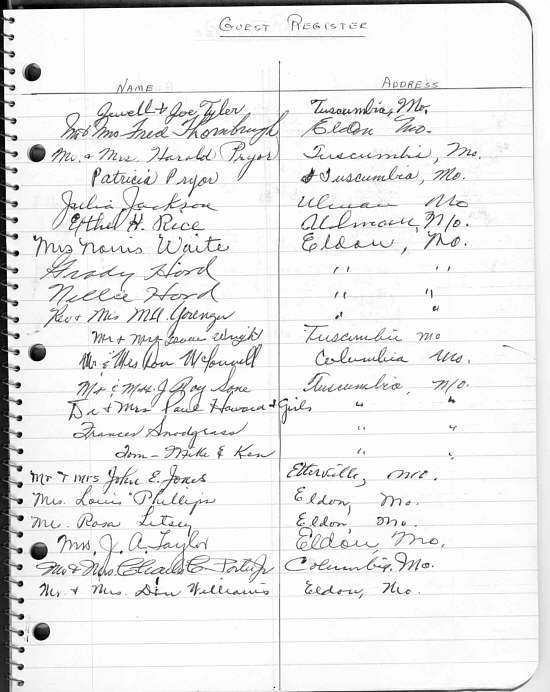 17 Open House
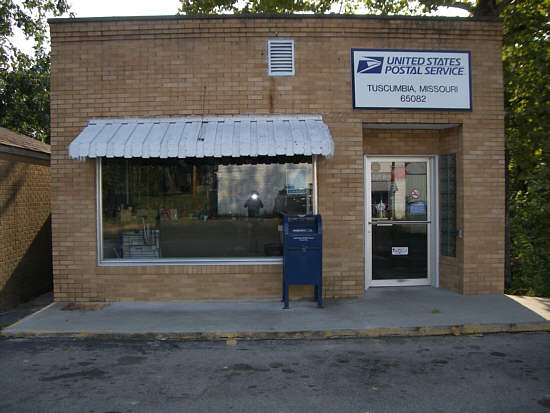 18 Current Post Office
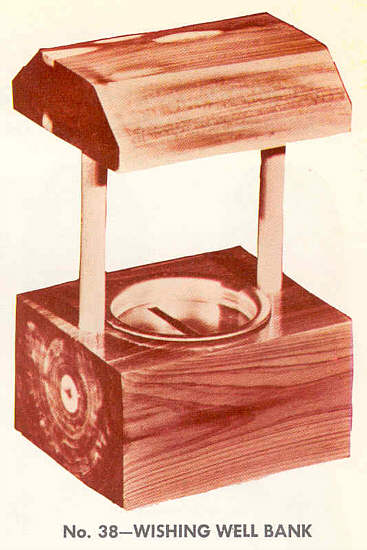 19 Wishing Well Bank Events scheduled for October at our museum include the Quarterly Dinner Sunday, October 14, beginning at 1:00 p.m. This is a potluck meal and all are invited. No charge is made but bring a covered dish and your own table service. If all goes as planned we will host the dinner in the lower level of our new building. So come and join us and be one of the first to enjoy the new facility. We plan to have the Joe Jeffries country style music group with us that day as well as a guest appearance by member Ellis Bray who has promised to sing a song he wrote remembering the J.R. Wells steamboat.
On Saturday, October 27 we will host our annual Chile Dinner at the museum. A small fee will be charged at the door for this event. Alan Wright, a native of Eugene, Missouri, whose roots are out of the Wright family of Saline Creek, will be our guest. He is a historian of our area and has recently written a book entitled Murder On Rouse Hill, based on a true story about an unsolved murder in a small Ozark town. Alan will be here to discuss the book as well as many interesting facts about the Miller County Wright family.
Our new building addition is in the finishing stages. Tile has been laid on the floor of the lower level and a wood floor will be laid within the next two weeks. Check our website (www.millercountymuseum.org) for regular updates on the new construction progress. We have had a good response to our fund drive as well as the benefit of much volunteer skilled labor from the community. Many contractors have given us a discount for labor and supplies. We are in need of volunteers to help us in hosting at the museum during visitors hours as well as other tasks. If you are interested in volunteering for the museum, contact Nancy Thompson, museum director, at 573 635 0606.
Last week I presented a narrative by my mother in which she recounted her memories of the many guests and renters who stayed in her home in Goosebottom while she was a young child. One of her memories referred to the many men who stayed there while working on the Bagnell Dam or one of the two bridges built in Tuscumbia during that time. Coincidental to that, I received this week a nice letter from Mildred Messersmith Gray, who reminded me that her husband, B.B. Gray had come to Tuscumbia to work on the present bridge, and that is how she met him. Mildred sent me a short synopsis of some of her memories and a review of the family history of her Messersmith ancestors. I thought that was interesting and reprint some of it here (also, you can read more about Charles Messersmith, Mildred's father (photo 20), on our own website at: http://www.millercountymuseum.org/people/bio_m.html
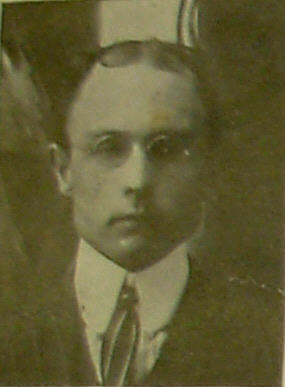 20 Charles Messersmith
Here is Mildred's summary of her family's history:
"Dear Joe,
My ancestor Andreas Messerschmidt came over in 1751. He settled in Pennsylvania and was of the Lutheran persuasion. Later, he and his sons moved to Virginia and subsequent to that moved to Missouri, Nebraska and Kansas. Grandfather Hiram Messersmith (Americanized spelling) married a Rowden girl. They lived near Iberia and had a big family. He was a Union soldier in the Civil War in the 12th Missouri Cavalry and is buried at the Tuscumbia Cemetery in the family plot. His wife and daughter are buried there too. Grandmother died in the flu epidemic. Her daughter, FidelIa, came from Kansas to see her but also caught the flu and died. I had a footstone put at Grandpa's grave to show he was a Soldier in the Civil War. His two sons were my father Charles and and his brother James. Both were teachers and James was principal at Tuscumbia High School later becoming county superintendent of schools as well. My father was county assessor four terms. He was a member of the Tuscumbia Christian Church and taught the Adult Bible class for many years. He died of cancer in 1939. Several years later my mother Minnie married Victor Nixdorf who died three years later. Some years later she married Fred Klindt and moved to live near Eugene. My mother and Charles Messersmith, my father, had seven children of which four survived (I, John, Betty Lou, and Juanita). During much of my childhood, we lived at the corner of highway 52 and High Street. We moved there from Iberia when I was in the first or second grade. My father operated a café at that location. The old school house (photo 21) was located on the north side of what is now highway 52 but closer to the corner than the present school. The high school boys were the janitors. I remember my brother John bringing in wood for the big potbellied stove in the bad winters. Little children who came in from the rural areas would be so very cold. John would wash their little hands with snow. I thought that was odd. Soon after moving to Tuscumbia the new school was built which is the one standing now, although with significant structural additions. Gardie Swanson was my teacher the third grade then Alma Kalllenbach was the teacher from fourth through eighth grade. The lower grades were taught on the first floor. For high school we moved upstairs.
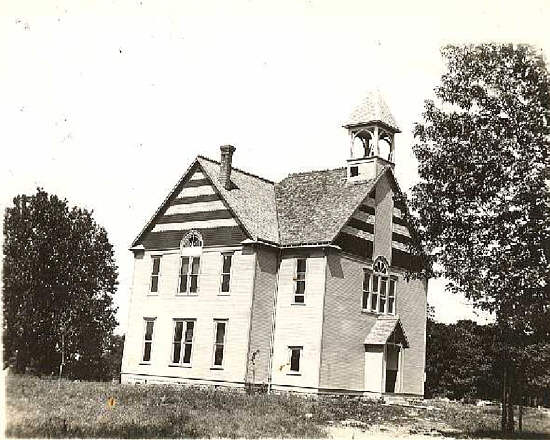 21 old school 1920 The man I married, B.B. Gray, came to Tuscumbia with the bridge building company and we married in 1935. We moved from State to State for six years then went to Panama Canal Zone where we lived for the next thirty years.
My younger sister, Betty Lou, married Ellis Smith. For a few years they operated the same Hillcrest café started by our father, Charles Messersmith. This restaurant and general store had several other owners after my father passed away in addition to my sister including Madison Bear, Arthur Bear, Tolliver Lawson, Earnest Abbett, and Roscoe Dake.
My other sister, Juanita Messersmith Stillwell, was Miller County Centennial Queen in 1937."
Mildred helped us with our story on the Centennial giving us photos and some personal information as well. You can read more about the Miller County Centennial on our website at:
http://www.millercountymuseum.org/events/centennial.html
We now have our first work of art for the new addition to the museum in place. Originating with an idea proposed by Carl McDonald, one of our longtime board members, Carl is the one who conceived and created it. Carl just loves the old field stone building in which is located our original museum and he wanted to preserve some of its character in the new building. So, since the two buildings are conjoined, we just quadrangled a good sized piece of the east wall of the old building and made it a piece of art with a fancy museum like name (photo 22).
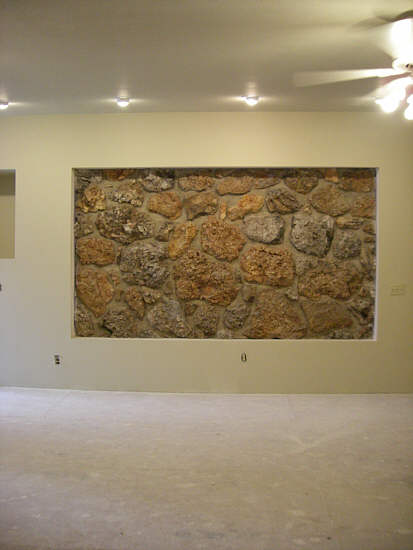 22 Las Rocas Del Campo A couple of weeks ago, we had quite a bit of information in this space about the bridges of Tuscumbia. Since then, I found an article by Peggy Hake which gives more details about the construction of the old suspension bridge (photo 23 of article as pdf 1.20MB).
The "What is it?" for this week is more of a "Where is it?" Do you know where this house is located and who was the original owner (photo 24)?
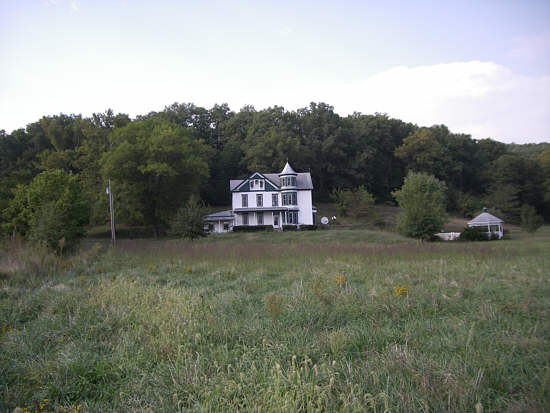 24 J.R. Wells Home It is the J.R. Wells house located on highway 17 about four miles northeast of Tuscumbia. The story about the house and the Wells family is interesting and you can read much more about it on our website at: http://www.millercountymuseum.org/homesteads/wells.html
This week Arthur and David Bear (photo 25) talk about how the depression affected Tuscumbia during the thirties leading into the beginning of World War II:
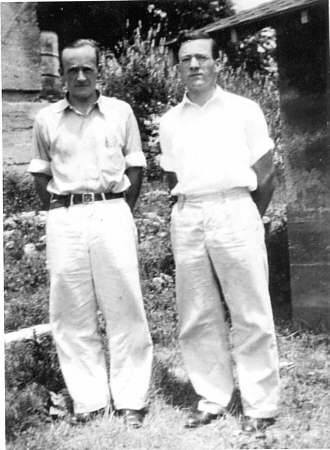 25 Arthur and David Bear Arthur: Around Bagnell Dam there wasn't any depression for awhile and around Eldon, they claimed there wasn't any
depression because there were so many Dam workers living there. But at Tuscumbia business really hurt. We had the general store (Woodman Hall photo 12 above) where we sold everything the farmer needed to buy: groceries, dry goods, shoes, ladies clothing and jewelry, house wares, farm machinery, horse harness, hardware, etc. It was the custom in those days for farmers to buy everything on credit until the crops were in, so they paid just once per year. That is as often as the farmers expected to pay and the merchants knew this and accepted it. So, when, I guess it was in 1929, the prices for farm products dropped to almost nothing, and the farmers didn't have enough money that fall to pay their debts. That hurt 'cause we then didn't have enough money to pay our bills on time, and this went on for several years. We lost a lot of money on the credit we extended. Most of the bills that farmers accumulated during that time were never paid. It really hurt. It got us to where we couldn't carry the stock of merchandise we needed. We just couldn't make it any longer. So in 1935 we moved to a little place on the hillside (Spearman building, see photo 11 of old post office above), yet it was still downtown. We had about the same procedures except we handled mostly groceries and things for the household. Mom also operated a small cafe on the upper level of the building. We did make a little money there. In 1938 I was still working for Dad, and there didn't seem to be any future in it for me, so I bought him out. Also, Mom's Parkinson's disease had progressed and she couldn't work anymore. Dad quit the Bagnell store the following year.
David: Well, the loss by fire of the store at Bagnell and the loss from extending credit kept Dad from becoming well off financially. Also, Dad and Mom felt sorry for hungry people who didn't have jobs. They gave away a lot of food and they gave credit when they knew they would never get paid. Gradually some government programs got started like the W.P.A. Also, the Tuscumbia bridge construction got under way in the early thirties which added some money to the local economy. Our family didn't suffer like many others. We always had plenty to eat and a good home to live in. There were some people who didn't have enough food, had insufficient clothing for the winter, and never had a decent place to live. Any money a person did get would go a long way. Food sold in the stores was very cheap. We mentioned a little about this earlier, Arthur. I believe that beans that was a staple item and could be bought for 5 cents per pound, Arthur.
Arthur: That's right 5 cents a pound.
David: Potatoes for how much?
Arthur: Fifteen cents a peck.
David: A peck is fifteen pounds. Why don't you give some of
the other prices at that time?
Arthur: Well, good coffee, the kind that" people there liked
was Peaberry. I don't know much about Peaberry coffee except it was good. It came in the grain and each home had a grinder and ground their own. It sold for 20 cents per pound, and some items like dried fruits sold for 10 cents per pound, except dried apples, raisins, and apricots which sold for 15 cents per pound. Men's work shoes cost $1.50 to $2.50. A good pair of nice calfskin dress shoes for men sold for $4.85. Women could get a nice silk dress for $10.95. Mom sold lots of yard goods that we called 80 square print at 20 cents per yard. Women did a lot of sewing then. I can't remember how much sugar cost, but I think it was $5.00 per 100 lbs. Even though prices were low, if you didn't have a job or money coming in, you couldn't buy it. That was a real problem until the W.P.A. came in. This was a government supported public works program. I don't know the rate of pay for the workers. It wasn't much but it kept many people from going hungry. At that time we didn't have the welfare programs that we have today. Medicare and Medicaid
didn't exist. Old age pensions including social security didn't exist. Occasionally an older person could get a state pension if a pauper. This was about ten dollars per month.
David: Times were really rough. It was worse in the big cities
where whole industries were shut down. Several families would often move into the same house to save money. An example was that Aunt Lora and Uncle Ernest Abbett moved in with Aunt Alma and Uncle Bob Craven for awhile (later in the early fifties the Cravens owned and operated the "Chicken Kitchen" at Lake Ozark on the strip). Cousin Faye Craven got married and she and her husband moved in with them. Our family didn't suffer for food or clothing, but we sure didn't have money to spend except for necessities. I remember that I wanted a bicycle very much one Christmas. A new one cost about $15.00 but I guess the money just wasn't available. I finally bought an old one for $2.00, but I never could get it to work because I didn't have the mechanical ability to fix it. As a boy, I did some things to earn money. We had a large garden plot so I sold garden produce to Dad who would take it to the Bagnell store. There weren't many ways" a young boy could earn money. I got a short-term job doing back-breaking work digging a basement. This job lasted about one week and I got paid 10 cents per hour. We had a cow which I milked, and Mom allowed me to sell some of it and keep the money. Dad usually bought it for 10 cents per quart and took it to Bagnell. Do you have any other reminisces, Arthur, of the depression era? We have talked about the depression and the Bagnell store. You can talk about either of these.
Arthur: Well! I don't think of anything right now.
David: The depression left one distinct impression on me. I
never want to be poor again like wanting something I can't have. My wants were never great, but the depression lasted so long that I really didn't like it. These hard times lasted through the thirties and part of the forties. World War II ushered in a rearmament program which opened many closed manufacturing plants and called for new ones to be built. Many new jobs were created and the depression started to wind-down. I graduated from high school in 1935 and laid out of school the following year and spent my time mostly in trapping and fishing to earn a little money. I enrolled in the Iberia Junior College in 1936 and attended for two years. Following this, I taught school at Bloodland, Missouri, for two years at $70.00 per month. Following this, I attended Springfield State Teachers College and graduated in 1941. I couldn't get a teaching job because of my 1-A draft status. I finally enlisted in the army where I could earn $21.00 per month plus room and board. It was shortly raised to $50.00 per month, and by the time I was mustered out, I was earning $66.00 per month. After getting out of the army, times were still rough financially for me. I got a job, but didn't make very much. These life experiences enabled me to appreciate the value of a dollar, even though a dollar isn't worth very much today. Arthur, surely you have
some more thoughts on this.
Arthur: Well, I was just going to say something I could have
said earlier. Just as the dam was completed in either 1931
or 32, they started working on a bridge across the Osage River at Tuscumbia. This was to replace an old one-lane suspension bridge that was owned by a local corporation. There was a toll fee for crossing it. It had become dangerous. I don't know how long it took to construct the new bridge, but it was quite awhile. It made a lot of employment but nothing like that created by the dam. It was finished in 1933 and this was followed by a dedication just a month after Lena and I were married. That was a big event. The governor and other state officials were there. I remember that they served about 4000 pounds of hamburger.
David: They also served a lot of barbecued ribs. The barbecuing was done on Jim Johnson's little piece of ground just across the street from our garden in Goosebottom (photo 26). The crew dug some trenches for the barbecue pits, then erected something above that to lay the ribs on. I don't know what they used for the heat. I suppose that the ceremonies were held in the park.
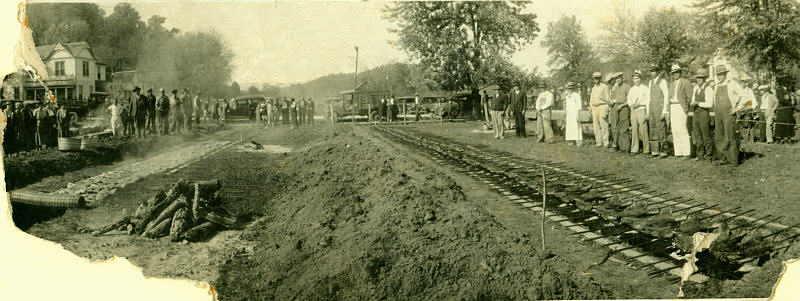 26 Celebration Barbcue 17 sep o7 Arthur: I read a few years ago that the bridge cost $135,000.
Think about it. Today the cost would be several million dollars.
David: Well, during the building of the bridge, Mom did make
a little money by renting some rooms to workers. We had a ten room house and a little building in the back which we called a smokehouse, but it really wasn't. This little building had two rooms which were fixed up to accommodate two or three workers. Most likely we rented two rooms on the lower floor of the house. During the construction of a road south of the bridge Mom rented two upstairs rooms to a man and his wife. We rented out some of the rooms for several years, and it brought in a little money to keep the family going. Mom and Dad were both enterprising people. Arthur eventually bought the Tuscumbia store from Dad and Mom. This was the store located on the bluff across the road from Hauenstein's store. You moved around several times in the next few years, didn't you?
Arthur: Yeah, I moved down on the river bank to a building owned by Jim Sweeney where Jim Johnson used to have a business . I bought the building and put in my store (photo 27). We had a big stock of groceries, and we still served sandwiches and short orders.
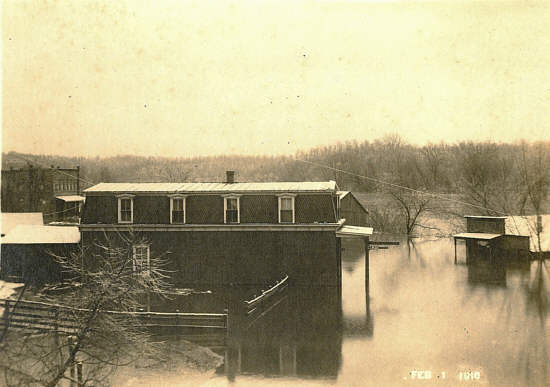 27 Fendorf building left, Johnson building right during a flood
David: Was this in 1937?
Arthur: That was in '38. In the meantime, I sold my cabin
camp next to the park to Jim Sweeney and then bought the store building from him. I operated there until 1943.
Then I burned out. After the store burned, I moved into the
old Farmers Exchange building (photo 28), and I was only there about three months until the record-breaking flood of 1943 got in the building, even into the upper story. This was the biggest flood in history on the Osage river.
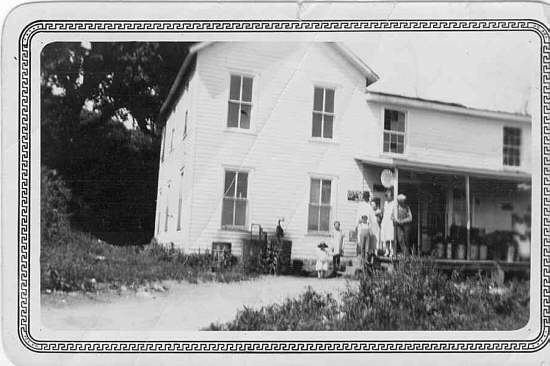 28 Farmer's Exchange; Susie,Marie,David,Sadie,Gertha,Arthur David: That was in '43?
Arthur: Yeah, '43. The river stage was 49 feet. This was,
oh, a lot higher than it had ever been. That just about ruined
us because we lost a lot of merchandise. We had moved the
merchandise upstairs in the building, and it really surprised
us when the water got three feet deep up there. We hurriedly
got some stuff out by loading into boats through an upstairs
window, but much of it was lost. I didn't go back in business
in that location. Tod Lawson wanted to sell his store and
restaurant that was located on top of the hill across from the
school. That was in June of '43 and I stayed until February
of '45.
David: It seems that disasters followed the family during those years.
Arthur: Yeah.
David: Floods were a common occurrence on the Osage. I can recall my first experience with one. I was about ten years old, and I thought it was great. I know the folks didn't think so, but I had a good time. I did a lot of rowing around in
our john boat. I also had three pet ducks that swam in circles
around the trees and had a great time. I believe that floods
were made for little boys and ducks. The backwater covered
all of the Goosebottom area. It surrounded our house and got into the lower floor three or four feet deep. This happened several times through the years. We would sleep upstairs. All the furniture and other belongings from the first floor were moved upstairs. The piano was too heavy, so we wrapped it in quilts and suspended it by ropes that went through the ceiling and were tied to saw horses upstairs. This procedure was followed during the big flood of '43, but then, the water got several feet deep upstairs and ruined all of our belongings except that which was hauled out rapidly by boat. The piano that was suspended was ruined. Some very fine walnut furniture made by our great grandfather fell apart. Dad didn't realize that it could have been reassembled by someone skilled in wood work, so he tossed it out in the backwater. He found our refrigerator floating, so he tied it behind the boat and towed it across the backwater to a new house he had just bought and plugged it in. It worked. During a flood, We would go back and forth to the store in our boat. I was always eager to do the rowing. So Arthur, after the great flood of '43 you moved on top of the hill and ran a store and restaurant, isn't this true? (Note: This store was the original Messersmith store mentioned above in Mildred Gray's letter).
Arthur: That's right.
David: This was while I was in service in world war II.
Arthur: Yeah, in June of '43. Oh yes, after I got up there on top of the hill a contingent of soldiers came over from Fort Leonard Wood to help the farmers reconstruct fences and drag driftwood from their fields. Whatever needed doing, the soldiers did. The government thought that farming was essential to the war effort. They were there, oh, perhaps six weeks.
David: I never heard of that.
Arthur: You didn't?
David: No, I wasn't there so I didn't know about it.
Arthur: Well, they camped out west of town where we used to play ball in Wiley Berry's field or pasture. That is where
we were playing baseball when you slid into what you thought was third base. (Note: probably only country kids would know what that was) We had the nearest business to them so the soldiers flocked in to our place. We would be there from 9:00 to 10:00 o'clock at night. Lena served meals to them. We did a thriving business there, especially while the soldiers were around. Tuscumbia was a county seat town, so we continued to have a good business after the soldiers were gone. Rationing was on so people came from all over the county to get their stamps. We were there about twenty months. By that time the draft board got after me. I went to Jefferson Barracks in '44 and passed a physical, then before they called me, a new directive came out that no fathers over age 27 would be inducted. That directive was in effect for about a year, then I was 'reclassified to 1-A. One of the draft board members told me that if I got into defense work, the chances were good that they wouldn't take me. I then sold the store to Dad and Garrett Berry. I went to Blue Springs, Missouri, and worked in the Lake City Ordinance plant until the war was over.
David: That happened while I was in the army and overseas in North Africa and Italy. The soldiers being there is completely new to me. I do remember a story that Dad told that happened when you were still at the store that burned. This happened in the early forties. A soldier from Fort Leonard Wood had come in the store one day and
one of the local boys from south of the river was drunk, and
he picked a fight with the soldier. This local citizen was
always belligerent when he got "liquored up." He loud-mouthed around with the soldier until they both got irritated. The local lad, true to form, went at the soldier with a knife.
The soldier knew that the knife wasn't for the purpose of cutting cheese, and rather suspected that the knife was meant for him instead. He espied a long stove poker next to the stove which fit his hand perfectly, so he picked it up and hit his aggressor across the head and knocked him out. A brother of the knocked out local citizen arrived and started objecting to the soldier about his unseemly behavior to which the soldier replied, "Do you want some of it, too?" Well, this brother didn't want "some of it, too," so there was no more action. Were you there at that time, Arthur?
Arthur: No but I have often wondered if those two fellows knocked some burning embers out of the wood stove while fighting and I have wondered if that is what caused the fire that burned me out.
David: That was Dad's story. I don't remember what year it
was, but he was there when it happened.
Arthur: That was in 1943. Fort Leonard Wood was a big
operation then.
Next week Arthur and David talk about some of the people around Tuscumbia who most influenced them.
I recently finished a book written by Bob Richardson titled Up The Caboose which was Bob's story about growing up in Eldon in the early twenties and thirties (photo 29). Eldon was a thriving railroad town then and Bob's father was a Rock Island Railway Conductor. Bob, who had the book published in 1991, is a talented writer with a huge sense of humor. The most fun is when he talks about all his friends and various characters of Eldon during those times and the messes, fights, and general mischievous things they did as kids. I think the book is out of print; I borrowed mine from David Shelton and have promised to loan it to my brother-in-law Paul Holder if David will let me keep it a little longer. But if you can find a copy, read it because it tells you lot about Eldon during those years. The most complete history of Eldon I have run across is the one compiled by Tina Raynor for the Eldon Centennial in 1982 entitled Eldon, A Look Back (photo 30). It is loaded with photographs and is also humorous at times as well as being very informative. I 'm not sure if the Eldon Chamber has any left but check and see because Tina's book is one that can't be overlooked when discussing Eldon history.
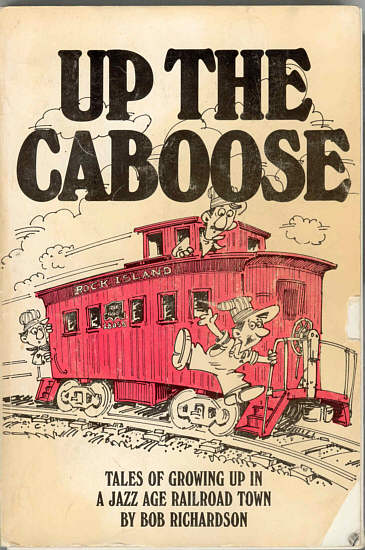 29 Up The Caboose
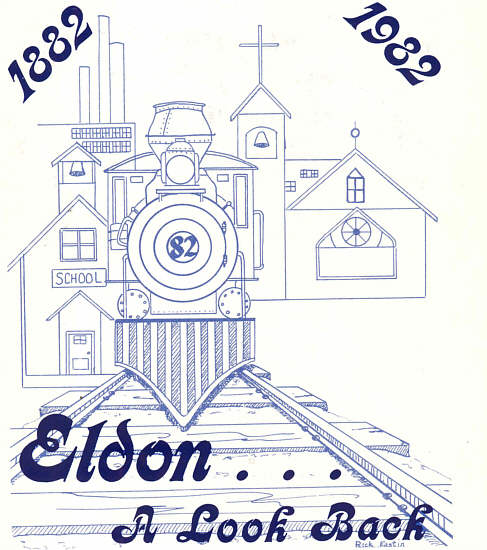 30 Eldon, A Look Back We will have a Miller County Museum display in the White House on the strip at Lake Ozark Friday, September 28 through Sunday, September 30 for the Oma and Noma Days Festival. Most of the time we will have a board member to greet passersby. I have to be out of the area during part of the weekend so I may not be there for the entire event. According to all the plans I have seen, the festival is going to be something you won't want to miss. You can read about it at this link: http://www.lakesunleader.com/articles/2007/09/23/news/06.txt
Well, that's all for this week. Hope you can click in next week about this same time.
Our address for donations is:
Miller County Building Fund
P.O. Box 57
Tuscumbia, Mo. 65082
| 






























